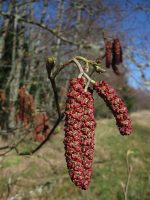
Red alder is a deciduous tree native to North America from southeast Alaska south to central coastal California with an extension inland across Washington and Oregon into northermost Montana. It is a member of the birch family, Betulaceae, that also includes hazels and hornbeams. The trees generally grow 40-50′ tall and have smooth, light gray bark that is often covered with lichens and moss. The oval to rhombic dull green leaves are 3-6″, have bluntly toothed edges that are curled under, and turn yellow in the fall. In early spring, male and female flowers appear in pendent reddish catkins on the same plant. The male catkins are produced at the tips of the branches and are longer than the female catkins that are positioned right below them. The female catkins are erect during the period that the flowers are open. The dry fruit is barrel-like and sheds seeds with winged margins in late fall and winter. The trees provide food and cover for wildlife and are useful as a hedge or screen. They are also valuable for reestablishing woodlands and controlling soil erosion especially along waterways. The genus name, Alnus, is the classical Latin name for the plant. The specific epithet, rubra, is the Latin word meaning red, and refers to the color of the inner bark.
Type: Deciduous tree
Outstanding Feature: Valuable as food source and cover for wildlife, controlling erosion, and restablishing vegetation in woodlands.
Form: Conical
Growth Rate: Rapid
Bloom: Flowers produced in male and female catkins in early spring
Size: 40-50′ H
Light: Full sun
Soil: Average to lean, moderately moist, well-drained
Hardiness: Zones 7-8
Care: Low maintenance
Pests and Diseases: Phytophthora root rot
Propagation: Seed, hardwood cuttings in winter, softwood cuttings in summer, bud grafting in late summer
Photo Credit: Walter Siegmund Wikipedia